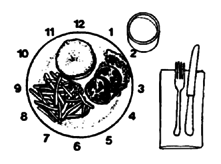
Help the child who cannot see well to do all kinds of things with her hands, including daily care of herself.: eating, dressing, bathing, and toileting. At first you may need to help the child feel things by guiding his hands.

To help the child know where to look for the different foods on her plate, try to always put them in the same place. As the child gets older and learns to tell time, have her think of the plate or bowl as a clock. Tell her at what time each type of food is put on her plate. Here the glass of water is at 2 o'clock. Always put it at 2 o'clock.
Help the child learn to put in the same place glasses, cups, bottles, and other things that can be easily spilled or broken. Teach her to remember where she puts things, and learn how to reach out for something and find it without knocking it over. Reaching out with the back of the hand causes less spilling. (This will take practice and there will be accidents, but that is the way she learns. Do not hand her everything or do everything for her, just to avoid a mess. Making a mess is part of learning.)
Teach the child about things he must be careful with or keep a distance from, to not get hurt: things such as fire, hot pans and dishes, sharp knives, dogs and mules that might bite or kick, deep holes, wells, cliffs, deep ponds or rivers. Do not just tell him "No!" Help him to understand the danger.
|
CAUTION: Whenever possible, keep dangerous things out of reach or put fences around them, and take other precautions to protect the child -especially until he is old enough to be careful. |
Also, look for games and toys that help the child develop her ability to feel fine details and small shapes with her fingers. For example, you can make dominos and dice out of wood. For the dots, hammer round-headed nails into the wood, so she can feel them. Or drill holes. The child can learn to feel the dots with her fingertips. At the same time, she will begin to learn to count and use numbers. You can start with 'giant' dominos and dice, and when her fingers learn to feel more skillfully, change to small ones. This will be good preparation for doing many kinds of fine work and perhaps for learning to read Braille.
Remember, most 'blind' children have some useful vision. Encourage the child to use whatever sight she has. If she can see big letters on the blackboard, write big and clear, and be sure she sits in the front. Be sure the light is good, and that dark letters and things stand out against a light background. If she can see at all, to help her learn the letters, make them very BIG. Use white paper and dark ink.
To help the child learn the shape of letters by feel, you could make them in one
of these ways.